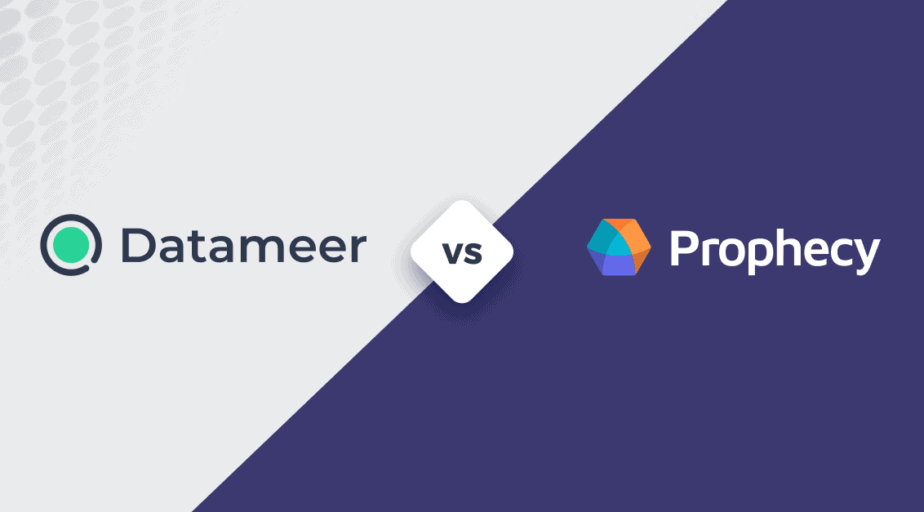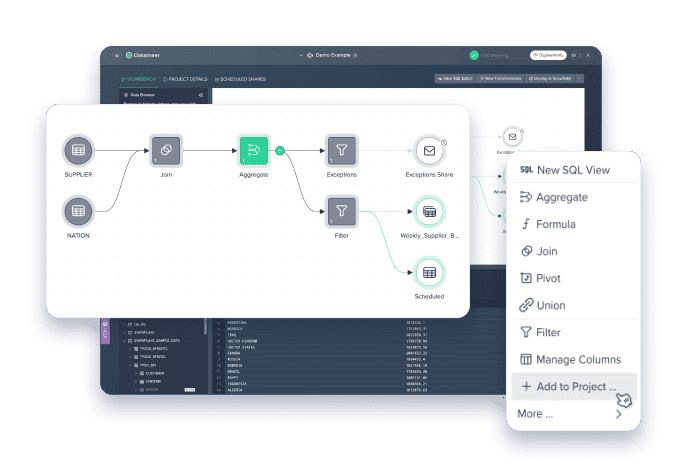Datameer vs. Prophecy.io: Exploring Features, Performance, and Cost for Modern Businesses
- Jeffrey Agadumo
- August 24, 2023

This article dives into a detailed comparison of Datameer vs. Prophecy, first highlighting their similarities, then contrasting their differences to give an idea of which best suits your use case.
As businesses strive to make informed decisions, they require efficient, user-friendly ways to analyze and visualize data. Tools that offer low-code transformation features to non-technical business users allowing them to harness the power of data effectively, are even more essential.
These easy-to-use data tools come with several advantages:
- Accessibility.
- Collaboration.
- Reduced Learning Curve.
- Real-time Analysis.
- Cost Efficiency.
Datameer vs. Prophecy: Core Features
Datameer

Datameer has been on a mission to democratize data analysis by bridging the gap between technical complexity and accessibility. This is noticeable in its low-code, easy-to-use features which give members of a data team access to self-service analytics irrespective of technical expertise. These features make it well known for boosting ad hoc analysis and collaboration within an organization.
Datameer’s visual editor on the dashboard allows users to build intricate and visual data workflows through simple drag-and-drop interactions.
This approach not only promoted self-service analytics but also fostered collaboration across teams.
Core Features:
- Intuitive Data Visualization: Datameer offers a visual and user-friendly data platform that empowers users of all skill levels to explore and analyze their data seamlessly. Users can easily navigate and interact with their datasets through intuitive interfaces, fostering a culture of data-driven decision-making.
- SQL and Pre-Built Operations: With Datameer, users can perform data transformations and analysis using SQL or leverage a library of pre-built operations. This dual approach allows users to choose the method that aligns best with their expertise, enabling them to manipulate and derive insights from their data efficiently.
- Automated Scheduling and Version Control: Datameer streamlines data workflows by providing automated scheduling and robust version control capabilities. Users can effortlessly schedule data processes, ensuring timely updates and consistent analysis. Furthermore, version control safeguards against errors, providing a reliable audit trail of changes.
- Accelerated Analytics with Visual Workflows: Datameer’s visual workflows enable users to construct complex data pipelines effortlessly using a drag-and-drop interface. This accelerates analytics by reducing manual coding efforts and allowing users to focus on extracting meaningful insights from their data.
- Easy Setup with Snowflake Integration: Datameer’s seamless integration with Snowflake simplifies setup and deployment. Users can quickly connect to their Snowflake environment, enabling rapid adoption of Datameer’s powerful analytics capabilities without the need for extensive configuration.
Prophecy.io

Founded in 2017, Prophecy is a startup that empowers data users of all skill levels to leverage Apache Spark’s capabilities. It offers a balanced approach combining low-code visual development with code-based operations, enabling expert data engineers and other business users to manage and transform data efficiently.
Core Features:
- Low-Code Spark-based Data Pipelines: Prophecy’s primary feature is its low-code platform allowing users of varying skill levels to create complex Spark-based data pipelines easily. The tool provides a visual editor where users can drag and drop icons (called gems) to construct their data workflows and automate data pipelines.
- Hybrid Visual and Code Editors: A standout feature of Prophecy is its “two-way” environment that allows users to switch between the visual editor and the code editor. Changes in either editor are instantly reflected in the other, and generated Spark code is stored in a Git repository.
- Data Source Integration: Users can seamlessly integrate data from various sources, including files, data warehouses, documents, databases, application APIs like Slack, supporting formats like Parquet, ORC, CSV, JSON, plain text, and Databricks’ Delta format. Moreover, users can develop both batch and streaming pipelines using the same APIs.
- Spark and Airflow Integration: The tool integrates seamlessly with Spark and Airflow environments. However, users must procure their own Spark and Airflow instances and access a Git repository.
- Support for Machine Learning: Prophecy’s Spark-based pipelines support machine learning tasks, allowing users to work with RDDs for more intricate operations.
- Open Source Compatibility: Prophecy aligns with the open-source philosophy by leveraging the power of Spark and Airflow. This approach reduces the risk of vendor lock-in and resonates well with enterprises seeking open-source standards.
Datameer vs. Prophecy: Major Comparisons
1. Scalability:
Datameer: Datameer offers scalability by leveraging Snowflake’s cloud-based infrastructure, enabling users to efficiently process and analyze large datasets. It supports parallel processing and can scale horizontally to accommodate growing data needs.
Prophecy: Prophecy provides scalability by utilizing Apache Spark’s distributed computing capabilities. It enables users to process and transform data at scale, making it suitable for handling complex data engineering tasks.
2. Cost:
Datameer pricing is priced per seat, keeping it easy to understand how much you are spending per month. No need to worry about usage, data volume, and deployment options causing unexpected costs.
Prophecy: Prophecy’s subscription-based pricing starts at $299 per month, making it more cost-effective for organizations looking to manage and transform data within a specific budget.
3. Integration:
Datameer: Datameer is built to maximize your Cloud Data Warehouse investment by transforming, analyzing and storing the data where it lives. Everything in Datameer is powered by live queries to your Snowflake.
Prophecy: Prophecy integrates with Apache Spark, DBT, and Airflow environments, offering users the flexibility to leverage their existing Spark and Airflow instances for data processing.
Final Thoughts
After comparing Datameer vs. Prophecy, the difference becomes apparent. Datameer is your go-to for quick ad-hoc analysis, allowing you to explore data and uncover insights on the fly. On the flip side, when handling complex data engineering tasks, Prophecy steps in with its automated Spark-based workflows, making data management a breeze. Deciding between the two boils down to your needs: Datameer for nimble analytics and Prophecy for tackling data engineering challenges head-on.
Is Datameer right for you and your organization?
Try it today and get accurate just-in-time reports when you most need them!


